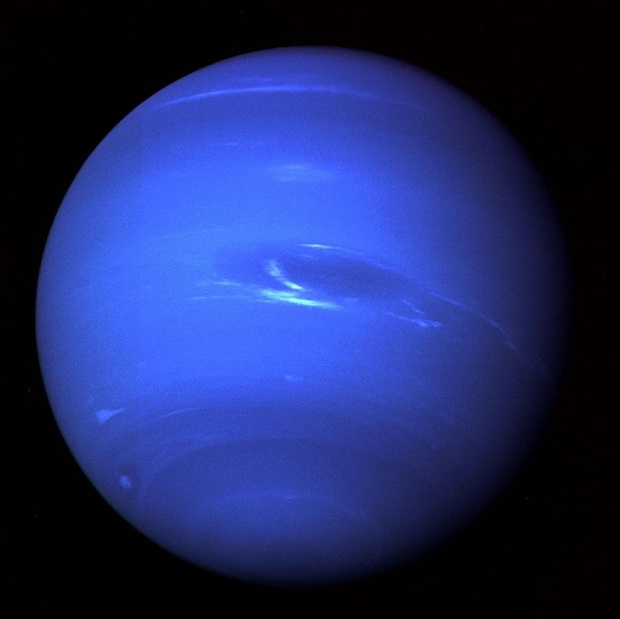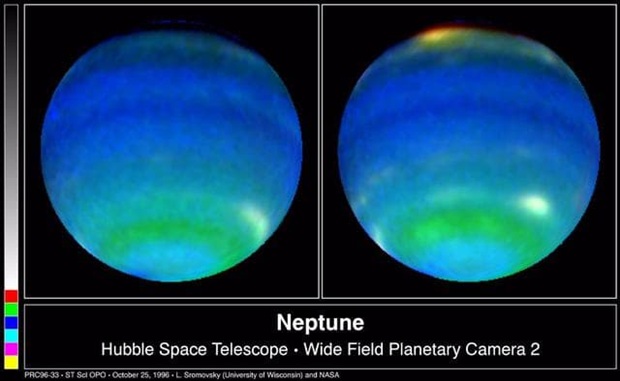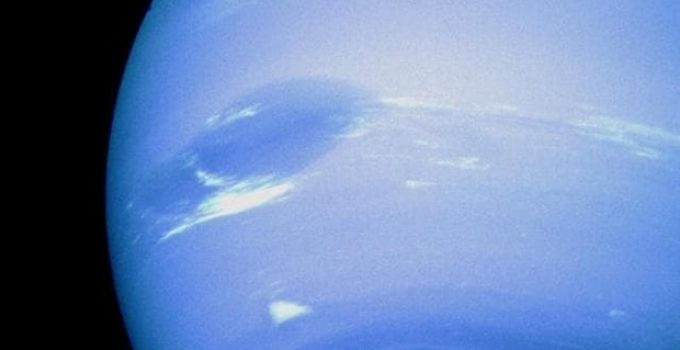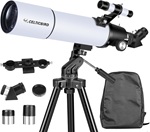Is Neptune Bigger Than Earth?
Answer at a Glance: Neptune is bigger than Earth. Neptune is larger than Earth in volume, diameter, and mass.
Dig Deeper
- Neptune’s Size Compared to Earth
- What Planets Are Larger Than Earth?
- Can You See Neptune from Earth?
- How Does Neptune’s Size Affect Orbit?
- Does Neptune’s Size Affect Surface Gravity?
- References
Neptune’s Size Compared to Earth

Image Courtesy NASA/JPL
Neptune is larger than Earth in volume, diameter, and mass.
- Diameter: Neptune has an equatorial circumference of 96,129 miles, which is 3.8647 times larger than the Earth. [1]
- Volume: With a volume of 15,000,714,125,712 mi3, Neptune has a volume 57.723 times Earth’s. [2]
- Mass: With a mass of 1.0241 x 1026 kg, Neptune has a mass of 17.148 times Earth’s. [3]
What Planets Are Larger Than Earth?
Four planets are larger than Earth: Neptune, Uranus, Saturn, and Jupiter. In terms of diameter, Neptune, the eighth planet from the sun, is nearly 4 times wider than Earth. Uranus, the seventh planet from the sun, is a little larger than Neptune and is 4 times wider than Earth. Saturn, the sixth planet from the sun, is 9 times wider than Earth. And finally, Jupiter, the fifth planet from the sun and the largest planet in our solar system is eleven times wider than Earth. [4]
Consider the volume differences to visualize how much bigger these planets are than Earth. In terms of volume, it would take 57 Earths to fill Neptune, 63 to fill Uranus, 764 to fill Saturn, and 1320 to fill Jupiter. [5][6][7]
Can You See Neptune from Earth?

Photo courtesy of: NASA/JPL/STScI
Even though Neptune’s diameter is nearly four times that of Earth, it is not visible from Earth with the naked eye. In fact, according to NASA, it is the only planet in the solar system that you can’t see from Earth. [8]
Neptune’s discovery is a fascinating tale of scientific ingenuity. Its invisibility to the naked eye led astronomers to first detect its existence through mathematical calculations based on unusual changes in Uranus’s orbit, the furthest known planet from the sun at the time. [9]
German astronomer Johann Gottfried Galle of the Berlin Observatory was the first to recognize Neptune as a planet in 1846 using a Fraunhofer telescope. [10]
Modern technology has brought us closer to Neptune. The Hubble Space Telescope, a marvel of modern astronomy, has captured numerous images of the distant planet. These images reveal Neptune’s striking blue appearance, a result of the methane in its upper atmosphere absorbing the sun’s red light and reflecting it back into space as blue. [11]
While Neptune is not visible to the naked eye, it is within reach of amateur astronomers. According to Sky & Telescope Magazine, you may be able to view Neptune with a telescope that has 4 inches or more of aperture. This possibility opens up a whole new world of observation for astronomy enthusiasts. [12]
How Does Neptune’s Size Affect Orbit?
The planet’s orbit is just as large as its size. It takes 164.791 Earth years for a single year to pass on Neptune. However, due to its faster rotation, at 16.11 hours, Neptune has fewer daily hours than Earth. [13]
Does Neptune’s Size Affect Surface Gravity?
While Neptune is substantially larger than Earth, its surface gravity of 36.6 ft/s² is relatively the same. According to NASA, if you weigh 100 pounds on Earth, you would weigh 114 pounds on Neptune. [14]
References
- [1][2][3][13] NASA – “Neptune Fact Sheet.”
- [4] NASA – Solar System Exploration: “Planet Sizes and Locations in Our Solar System.”
- [5] Space.com – “How Big Is Earth?”
- [6] Cool Cosmos – “How Big Is Uranus?”
- [7] Cool Cosmos – “How Big Is Saturn?”
- [8] NASA – “Neptune Facts.”
- [9][10] NASA – “175 Years Ago: Astronomers Discover Neptune, the Eight Planet.”
- [11] Cool Cosmos – “Why Is Neptune Blue?”
- [12] Sky & Telescope Magazine – “Ice Giants: The Discovery of Neptune and Uranus.”
- [14] NASA – Solar System Exploration – “Planets: Neptune.”

